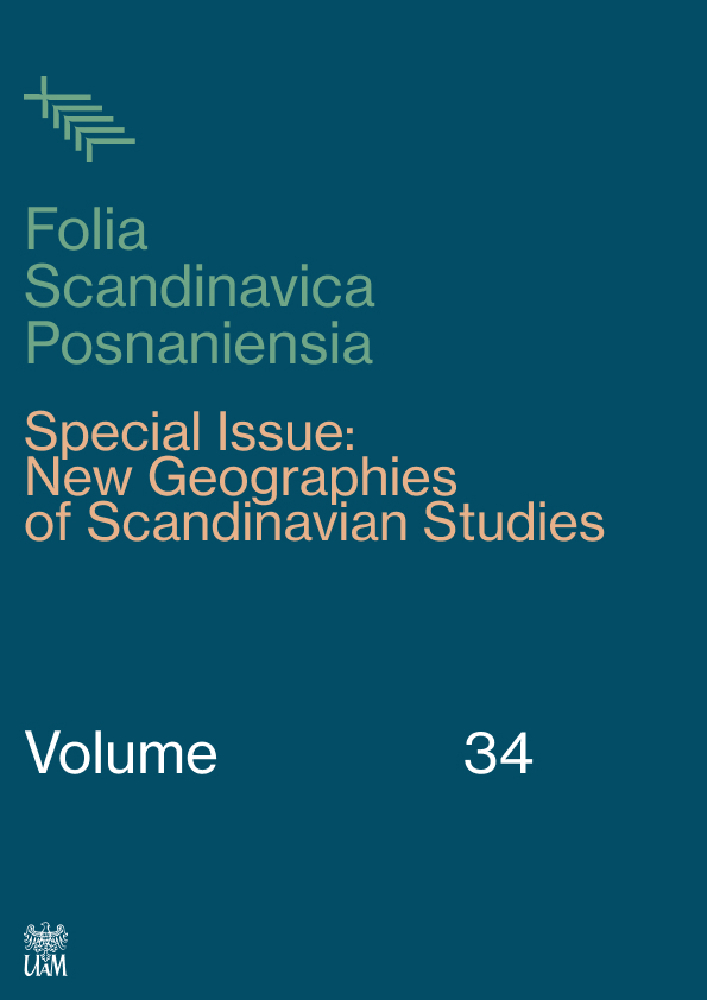Abstract
This co-written article approaches the influential Lithuanian writer and playwright Marius Ivaškevičius’s essay series My Scandinavia (2004) from two different vantage points reflecting either side of the former ‘Iron Curtain’. Published in the year when Lithuania joined the European Union, the essay series describes the narrator’s travels and symbolic and ironic conquest of Northern Europe in the wake of the border openings following the collapse of the Soviet Union. First, employing the notions of “temporal” and “spatial nodes” (Ringgard & DuBois 2017), the article addresses how the crossings of the Baltic Sea and journeys through Northern Europe depicted in Ivaškevičius’s essays represent an awareness of significant shifts in the unfolding of European history and Europe’s spatial configuration. Second, the article reads My Scandinavia as an example of creative map-making in line with theories of critical cartography. Finally, the article puts the travelling subject in My Scandinavia centre stage, looking at the dialectic ways in which subject and place create each other. Just as Scandinavia has been actively moulding the narrating and, by implication, also the writing subject’s biography, so has he given Scandinavia shape through his discourse, while also idiosyncratically framing Europe’s shifting political and mental geography.
References
Domeikaitė, A. (2013). Marius Ivaškevičius: „Šaukiantys „Lietuva lietuviams!“ turi labai siaurą akiratį“ (Interview with Marius Ivaškevičius). 15min.lt. 23 February 2013. Retrieved from https://www.15min.lt/kultura/naujiena/asmenybe/marius-ivaskevicius-saukiantys-lietuva-lietuviams-turi-labai-siaura-akirati-285-310014 (accessed 29 March 2023).
Ivaškevičius, M. (2004). Lithuania: The howling wolf. Index on Censorship 33(3), 161–167. Retrieved from https://www.tandfonline.com/doi/epdf/10.1080/03064220408537389 (accessed 29 March 2023). DOI: https://doi.org/10.1080/03064220408537389
Ivaškevičius, M. (2005). My Scandinavia I–VII, translated by L. Sruoginis. Eurozine. Retrieved from https://www.eurozine.com/my-scandinavia-i/; https://www.eurozine.com/my-scandinavia-ii/; https://www.eurozine.com/my-scandinavia-iii/; https://www.eurozine.com/my-scandinavia-iv/; https://www.eurozine.com/my-scandinavia-v/; https://www.eurozine.com/my-scandinavia-vi/; https://www.eurozine.com/my-scandinavia-vii/ (accessed 29 March 2023).
Ivaškevičius, M. (2005). Mano Skandinavija I–VII. Eurozine. (First published in Šiaurės Atėnai in 2004). Retrieved from https://www.eurozine.com/my-scandinavia-i-3/; https://www.eurozine.com/my-scandinavia-ii-3/; https://www.eurozine.com/my-scandinavia-iii-3/; https://www.eurozine.com/my-scandinavia-iv-3/; https://www.eurozine.com/my-scandinavia-v-3/; https://www.eurozine.com/my-scandinavia-vi-2/; https://www.eurozine.com/my-scandinavia-vii-2/ (accessed 29 March 2023).
Ivaškevičius, M. (2016). Die wunderbaren Menschen aus der Depressionszone, translated by R. Veser. Frankfurter Allgemeine Zeitung, 18 August 2016. Retrieved from https://www.faz.net/aktuell/feuilleton/zwischen-russland-und-ukraine-menschen-in-luhansk-14390932-p4.html (accessed 29 March 2023).
Ivaškevičius, M. (2017). In love with Europe, translated by R. Kinka. Eurozine. Retrieved from https://www.eurozine.com/in-love-with-europe/ (accessed 29 March 2023). First published in German as translated by R.Veser. Frankfurter Allgemeine Zeitung, 6 February 2017.
Ivaškevičius, M. (2023). Dein Mann ist tot. Frankfurter Allgemeine Zeitung, 22 February 2023. Retrieved from https://www.faz.net/aktuell/feuilleton/debatten/ukraine-krieg-mariupol-und-ein-film-ueber-die-stadt-in-flammen-18695701.html?fbclid=IwAR2czSfOM3wcqJAauG9kr02hKk3C-6NENwsCh7TVli8Oh88SODJeFaHvjdw (accessed 31 March 2023).
Jauniškis, V. (2013). Marius Ivaškevičius: tie, kurie rėkia “Lietuva – lietuviams,” nebuvo toli išvažiavę iš savo Kauno ar Vilniaus (Interview with Marius Ivaškevičius). Delfi.lt, 17 March 2013. Retrieved from https://www.delfi.lt/news/daily/lithuania/mivaskevicius-tie-kurie-rekia-lietuva-lietuviams-nebuvo-toli-isvaziave-is-savo-kauno-ar-vilniaus.d?id=60923719 (accessed 29 March 2023).
Andriukonis, T. (n.d.). The scandal over Marius Ivaškevičius’ novel “Žali” (The Green). Mo Museum. Retrieved from http://www.mmcentras.lt/the-scandal-over-marius-ivaskevicius-novel-zali-the-green/78658 (accessed 31 March 2023).
Annus, E. (2018). Soviet postcolonial studies. Abingdon, New York: Routledge. DOI: https://doi.org/10.4324/9781315226583
Apsalons, E. (1996). Baltic unity – illusion or reality? In A. Lejiņš, D. Bleiere (eds.), The Baltic states: Search for security (pp. 201–219). Riga: Latvian Institute of International Affairs.
Brezeanu, M. (2023). Un interviu cu Ada Hausvater. Agenda LiterNet.ro. Retrieved from https://agenda.liternet.ro/articol/27059/Mihai-Brezeanu-Ada-Hausvater/Timisoara-veche-se-va-citi-prin-Timisoara-noua-Programul-pe-care-l-am-gandit-pentru-2023-inseamna-o-sansa-de-a-creste-in-societate-nivelul-de-perceptie-de-constientizare-si-de-raliere-la-conceptele-si-temele-europene-ale-momentului.html (accessed 29 March 2023).
Crampton, J. W. & Krygier, J. (2006). An introduction to critical cartography. ACME: An International Journal for Critical Geographies 4(1), 11–33.
Cresswell, T. (2004). Place: A short introduction. Malden, MA: Blackwell Publishing.
Czapliński, P. (2020). Literature and geography. Porównania 27(2), 143–166. DOI: https://doi.org/10.14746/por.2020.2.8
D’Ignazio, C. (2020). Art and cartography. In A. Kobayashi (ed.), International encyclopedia of human geography, 2nd edition (pp. 187–207). Elsevier. DOI: https://doi.org/10.1016/B978-0-08-102295-5.10510-4
Engberg-Petersen, A. (ed.). (2017). Literature and cartography: Theories, histories, genre. Cambridge, MA: MIT Press. DOI: https://doi.org/10.7551/mitpress/11177.001.0001
Gaižiūnas, S. (2008). Skandinavų literatūros ir baltiškieji kontekstai. Vilnius: Pasviręs pasaulis.
Guðni Jóhannesson (2016). Icelandic support for Baltic independence: myth, memory and detachment. Ajalooline Ajakiri 3/4(157/158), 431–445. Retrieved from https://ojs.utlib.ee/index.php/EAA/article/view/AA.2016.3-4.05/8349 (accessed 30 March 2023). DOI: https://doi.org/10.12697/AA.2016.3-4.05
Heitmann, A. (2010). Landnahme als Verlusterzählung: Karen Blixens/Isak Dinesens Den afrikanske Farm / Out of Africa. In H. Eglinger & A. Heitmann (eds.), Landnahme: Anfangserzählungen in der skandinavischen Literatur um 1900 (pp. 147–173). München: Wilhelm Fink. DOI: https://doi.org/10.30965/9783846749746_007
Iva Company (2022). The dawn of the gods. festival off Avignon 2022. Retrieved from https://iva-company.com/2022/07/12/the-dawn-of-the-gods/ (accessed 30 March 2023).
Joteikaitė, E. (2022). Marius Ivaškevičius užprotestavo spektaklio pagal savo pjesę “Dievų aušra” rodymą: nesutapo jo ir režisieriaus požiūriai. Delfi.lt. Retrieved from https://www.delfi.lt/kultura/naujienos/marius-ivaskevicius-uzprotestavo-spektaklio-pagal-savo-pjese-dievu-ausra-rodyma-nesutapo-jo-ir-rezisieriaus-poziuriai-91583387 (accessed 30 March 2023).
Jurgutienė, A. (2015). The deconstruction of national identity in Lithuanian literature: Marius Ivaškevičius’ plays. Interlitteraria 20(1), 23–34. Retrieved from https://ojs.utlib.ee/index.php/IL/article/view/IL.2015.20.1.3/7264 (accessed 31 March 2023). DOI: https://doi.org/10.12697/IL.2015.20.1.3
Karjalainen, P. T. (2003). On geobiography. Studies in environmental aesthetics and semiotics: Koht ja paik / Place and location 3, 87–92. Retrieved from https://www.eki.ee/km/place/koht_3.htm (accessed 30 March 2023).
Körber, L.-A. (2020). Mapping Greenland. The Greenlandic flag and critical cartography in literature, art and fashion. In L.-A. Körber & E. Volquardsen (eds.), The postcolonial North Atlantic: Iceland, Greenland and the Faroe Islands, 2nd edition (pp. 361–390). Berlin: Nordeuropa-Institut der Humboldt-Universität zu Berlin.
Pakštas, K. (2005). The Baltoscandian confederation. Vilnius: Versus Aureus.
Pratt, M. L. (2008). Imperial eyes: Travel writing and transculturation, 2nd edition. Abingdon, New York: Routledge.
Ringgaard, D. & DuBois, T. A. (2017). The framework. Spatial nodes. In S. P. Sondrup, M. B. Sandberg, T. A. DuBois & D. Ringgaard (eds.), Nordic literature: A comparative history. Volume I: Spatial nodes (pp. 19–29). Amsterdam, Philadelphia: John Benjamins. DOI: https://doi.org/10.1075/chlel.xxxi.02rin
Rossetto, T. (2014). Theorizing maps with literature. Progress in Human Geography 38(4), 513–530. DOI: https://doi.org/10.1177/0309132513510587
Sprindytė, J. (2005). Debesų Lietuva: Marius Ivaškevičius – mitų perkūrėjas. Darbai ir dienos 42, 175–188. Retrieved from https://portalcris.vdu.lt/server/api/core/bitstreams/76c4f08c-c1c5-4b3e-bb47-55544ae61d94/content (accessed 30 March 2023).
Steiblytė, K. (2018). Lithuanian drama export – a project for the future, Baltic Lines. International Conference on Baltic drama, 24–26. Tartu: Estonian Theatre Agency. Retrieved from https://teater.ee/static/files/056/baltic_lines.pdf (accessed 30 March 2023).
Tally, Robert T. (ed.). (2014). Literary cartographies: Spatiality, representation, and narrative. New York: Palgrave Macmillan. DOI: https://doi.org/10.1057/9781137449375
The Jewish Community of Lithuania. (2021). Five Years On Molėtai Marches Again, 26 August 2021. Retrieved from https://www.lzb.lt/en/2021/08/26/five-years-on-moletai-marches-again/ (accessed 30 March 2023).


